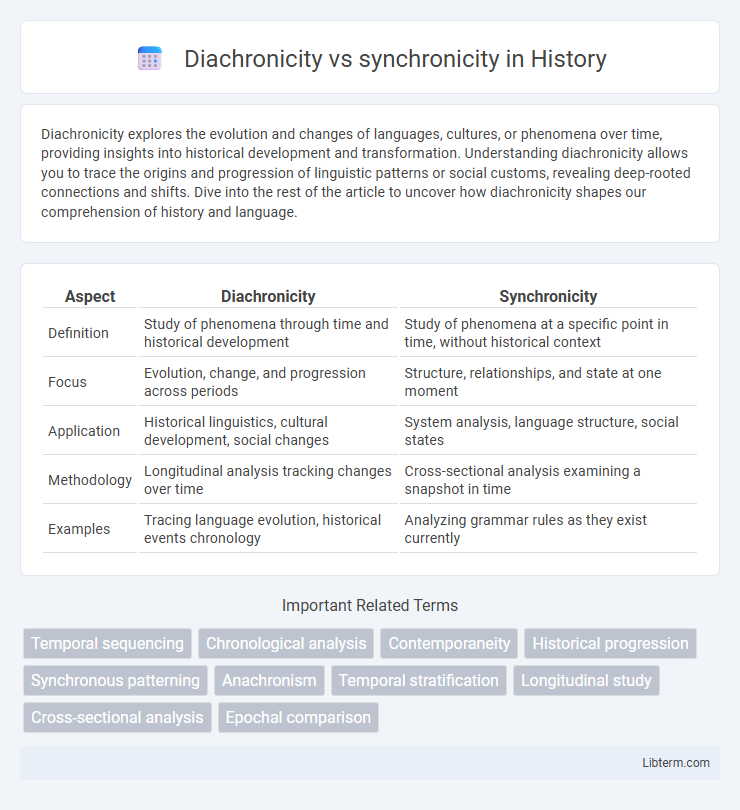Diachronicity explores the evolution and changes of languages, cultures, or phenomena over time, providing insights into historical development and transformation. Understanding diachronicity allows you to trace the origins and progression of linguistic patterns or social customs, revealing deep-rooted connections and shifts. Dive into the rest of the article to uncover how diachronicity shapes our comprehension of history and language.
Table of Comparison
| Aspect | Diachronicity | Synchronicity |
|---|---|---|
| Definition | Study of phenomena through time and historical development | Study of phenomena at a specific point in time, without historical context |
| Focus | Evolution, change, and progression across periods | Structure, relationships, and state at one moment |
| Application | Historical linguistics, cultural development, social changes | System analysis, language structure, social states |
| Methodology | Longitudinal analysis tracking changes over time | Cross-sectional analysis examining a snapshot in time |
| Examples | Tracing language evolution, historical events chronology | Analyzing grammar rules as they exist currently |
Understanding Diachronicity: Meaning and Context
Diachronicity refers to the study of phenomena, such as language or culture, as they change and develop over time, emphasizing historical progression and transformation. It contrasts with synchronicity, which examines systems at a specific point in time without considering historical context. Understanding diachronicity involves analyzing temporal sequences, evolutionary patterns, and contextual shifts to grasp the dynamic nature of change within a subject.
Synchronicity Explained: Definition and Key Concepts
Synchronicity, coined by Carl Jung, refers to meaningful coincidences that occur with no causal relationship yet seem significantly related. It challenges traditional notions of time and causality, emphasizing the simultaneous alignment of events with psychological states. Key concepts include acausal connecting principles, collective unconscious, and archetypes, which together explain how seemingly unrelated occurrences can mirror inner experiences.
Historical Origins: Diachronic and Synchronic Approaches
The historical origins of diachronic and synchronic approaches trace back to linguistic studies pioneered by Ferdinand de Saussure, who distinguished diachronic analysis as the study of language development over time and synchronic analysis as the examination of language at a specific moment. Diachronic methods focus on historical evolution and transformation, revealing linguistic changes and their causes, while synchronic methods analyze structural relationships and patterns without temporal considerations. These conceptual frameworks have profoundly influenced not only linguistics but also fields like anthropology, history, and sociology by shaping methodologies for understanding complex systems either through temporal progression or static analysis.
Structuralism and Linguistics: A Comparative Framework
Diachronicity examines language evolution over time, tracing historical developments and changes in phonetics, grammar, and semantics, while synchronicity analyzes language structures at a specific moment, emphasizing systematic relationships within linguistic elements. Structuralism in linguistics, especially through Ferdinand de Saussure, prioritizes synchronic analysis to reveal the interdependent nature of language signs and underlying systems. This comparative framework highlights how diachronic approaches provide historical context whereas synchronic perspectives offer insights into the stable organization of language structures.
The Role of Time in Diachronic and Synchronic Analysis
Diachronic analysis examines linguistic or cultural phenomena through the lens of historical development and evolution over time, emphasizing chronological change and progression. Synchronic analysis focuses on studying a language or culture at a specific point in time, capturing the structure and relationships within that particular moment. The role of time is crucial, as diachronic approaches reveal transformation and origins, while synchronic perspectives provide a snapshot of stability and system organization.
Application in Social Sciences: Evolution vs. Structure
Diachronicity in social sciences examines social phenomena through historical evolution and temporal changes, revealing how societies transform over time. Synchronicity focuses on the structure of social systems at a specific moment, analyzing relationships and functions within static contexts. Applying diachronicity illuminates social dynamics and development, whereas synchronicity provides insights into current social organization and interdependencies.
Language Change: Diachronic Perspectives
Diachronicity in language change examines the historical development and evolution of linguistic features over time, tracing shifts in grammar, phonetics, and semantics across different eras. This perspective contrasts with synchronicity, which studies a language at a specific point without considering its historical context. Diachronic analysis provides critical insights into language change by revealing patterns of innovation, retention, and borrowing that shape modern languages.
System Analysis: Synchronic Views and Implications
Synchronicity in system analysis emphasizes examining systems at a specific point in time, allowing analysts to identify structural relationships and current interactions within a system without considering historical evolution. This approach facilitates understanding of system stability, functional dependencies, and emergent properties by capturing a snapshot of system components and their interrelations. Emphasizing synchronic views supports the development of models that predict behaviors based on present configurations, which is critical for real-time decision-making and immediate problem-solving.
Advantages and Limitations: Diachronicity vs Synchronicity
Diachronicity provides a comprehensive understanding of linguistic evolution by analyzing language changes over time, allowing researchers to trace the development of phonetics, syntax, and semantics, but it can be limited by historical data scarcity and interpretative challenges. Synchronicity offers a snapshot of language at a specific moment, facilitating detailed structural analysis and comparison across dialects or languages, yet it may overlook historical context and evolution, limiting insights into language progression. Balancing diachronic and synchronic approaches enables linguists to address both historical development and contemporary usage, though methodological constraints persist in integrating these perspectives fully.
Choosing the Right Approach: Practical Considerations
Choosing between diachronicity and synchronicity depends on research goals and context; diachronicity analyzes changes over time, suitable for historical linguistics and evolutionary studies, while synchronicity examines phenomena at a specific point, ideal for structural or comparative analyses. Practical considerations include data availability, temporal scope, and the need for temporal causality versus systemic description. Researchers must assess whether understanding development trends or capturing a snapshot of interrelated elements better addresses their analytical objectives.
Diachronicity Infographic

 libterm.com
libterm.com